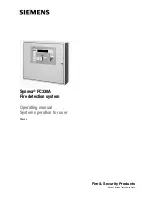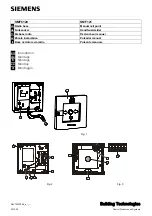
Page 4
5.0
INSTALLATION AND WIRING GUIDE
5.1
MOUNTING THE CIE EQUIPMENT
Identify a suitable location for mounting the CIE (Control Indicator Equipment) taking into
consideration the routing of cables and access to the CIE for both installation and user. Remove
the PCB and keep safe, mark the location of the holes to be drilled by offering the CIE rear
enclosure to the wall. Drill holes for suitable rawl plugs to provide a strong and secure installation.
2.0
CONNECTIONS
2.1
Terminal Diagrams
2.2
FIELD CONNECTIONS - TB3
These terminals provide the outputs to drive the internal and external sounders and strobes.
There are two separately fused outputs, both circuits are monitored for open and short
circuits conditions with EOL monitoring resistors (6K8). Sounders must be polarised, fully
suppressed and designed for 24VDC operation. The total load for both circuits must not
exceed 750mA. If the sounders or strobes are not polarized a fault will be indicated. The
same wiring rules apply as for the detector circuits.
+
BELL 1
-
+
BELL 2
-
REMOTE
RING
The REMOTE RING terminals can be used to force trigger the bell relay without a fire
condition occurring or operating the auxiliary relay. This gives the ability to wire remote
evacuation switches. This is NOT a latching trigger and will return to a normal state when the
connection is broken. Often used as a class change.
C
NO
NC
A
U
X
The CIE is fitted with a double pole auxiliary 1 Amp relay which operates only when a fire
condition is recognised. The relay does not operate if the manual SOUND ALARM is pressed.
+
BATT
-
These terminals provide connection for a 24V backup battery. 12V batteries are connected in
series. The 6K8 Ohm resistor must be removed before fitting any battery to this terminal.
Failure to remove the resistor will not enable the panel to test the batteries health.
2.3
KEY SWITCH - TB2
KEYSW
These terminals provide the connection for the on board key switch which enables and
disables the control buttons. When the switch is closed the control buttons are enabled. No
other connection should be made to these terminals.
2.4
A/C SUPPLY INPUT - TB1
A/C
These terminals provide the connection from the on board transformer, which provides
approximately 32 V ac. No other connection should be made to these terminals
2.5
INTERNAL BUZZER - TB4
BUZZER
These terminals provide the connections to supply a wired internal buzzer. These terminals
are only fitted when the on board buzzer SND1 is not fitted. No other connection should be
made to these terminals.
+
ZONE 2
-
+
ZONE 1
-
These terminals provide the inputs allowing the connection of smoke heads and alarms
points to the CIE. All devices must be connected in parallel to the CIE. 22V DC is supplied to
the zone terminals suppling a maximum current of 50 mA per zone, a 6K8 Ohm end of line
resistor must be fitted in the further most detection device from the CIE. To produce a fire
state the detector should draw sufficient current to trigger a fire alarm and have a 470 Ohm
resistor in series. Not only do the terminals detect a fire state but they offer detection of open
and short circuit of the cables.
FIRETRAX CIE PANEL
4.11
REMOTE RING
The connection of a normally open switch to the remote ring terminals, will allow the external sounders to be
used for ancillary functions for example 'Class Change.' Multiple switches can be used by connecting the
switches in parallel.
This work must be carried out by a suitably qualified engineer and installed to the latest mandatory
Fire Alarm Installation Regulations which are applicable at the time of installation. The correct
polarity must be observed and a good earth must be used.
The Fire Alarm system must not share its mains supply with any other electrical circuit and should
be connected via an isolating protective device and labelled 'FIRE ALARM DO NOT SWITCH
OFF.'
Wire To Mains
Power Supply
5.3
MAINS CONNECTION
Terminate the mains connection using suitable earthed mains cable to a fused supply, ensuring all
power is isolated before attempting to terminate and wires. This supply should not be shared with
any other appliances.
5.2
PRE-INSTALLATION TESTING
It is STRONGLY recommended that the panel is powered up and tested prior to the external
system circuits being connected.
•
Make sure the external system wiring has been tested and the results recorded.
•
Connect the batteries together (see
FIG 5.4,
page 10) and connect the + & - 'spade terminals'
to the PCB terminal block. Ignore the fault indication at this stage.
•
Connect the mains supply (see
FIG 5.3,
page 9). The fault indication will be removed
•
In turn, temporally disconnect each of the monitoring resistors from the terminals, check for
a fault indication, and reconnect for the fault to reset.
•
In turn, use a 470 ohm resistor to temporally connect across the detector circuit terminals
to create a FIRE condition. Reset as per the Operating Instructions.
Once the panel has been tested and the operating procedure is understood, the external
connections can be made, ONE CIRCUIT AT A TIME.
Page 9
VI40.1 Created 05/11/2001 Issue 1.3





















